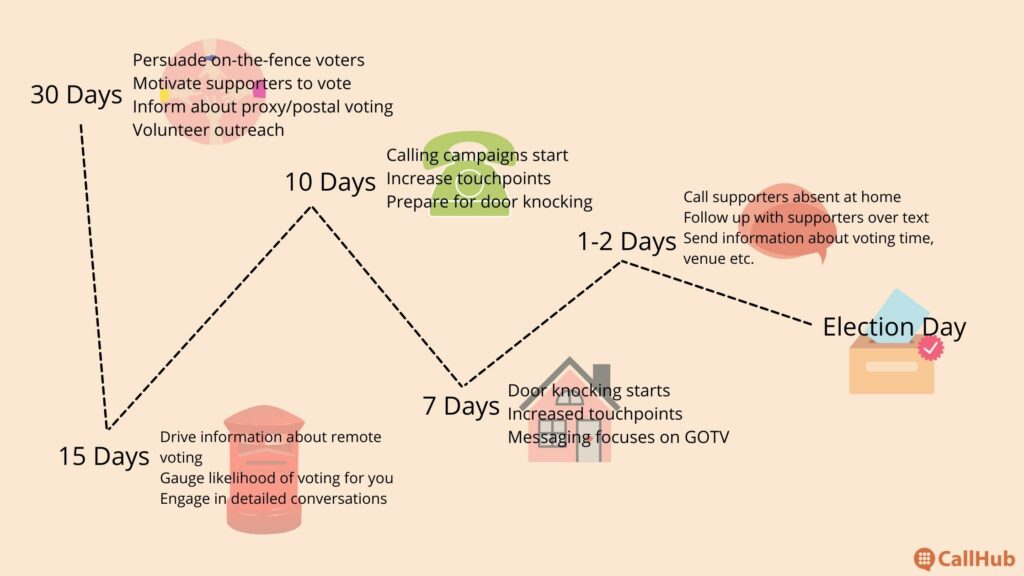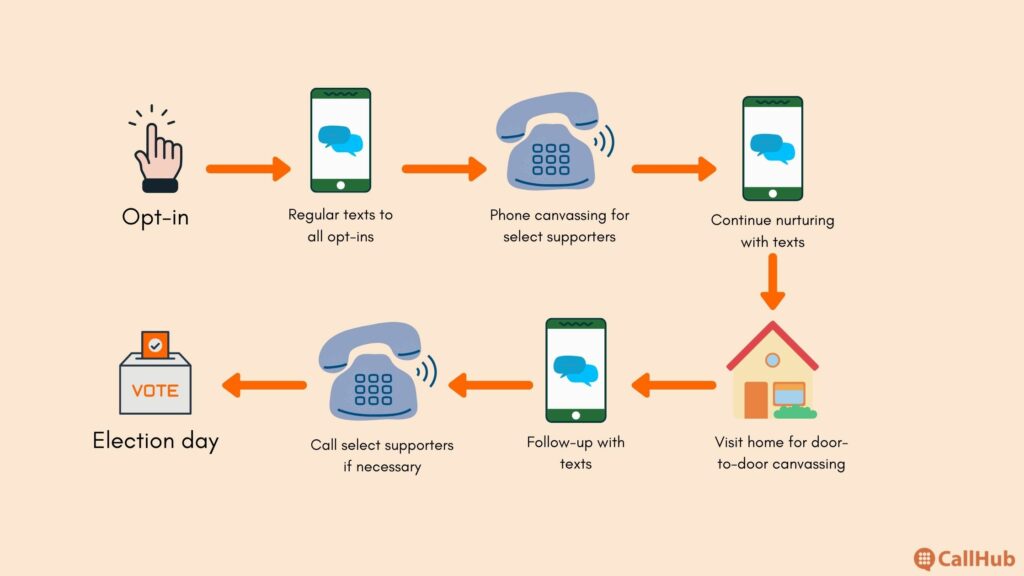Table of Contents
The average voter turnout during the 2018 UK elections in England was just 35%. That means nearly two in every three people were just not motivated enough to vote. Your local election campaigning efforts and voter nurturing during it determine if and how many of your supporters step out (or return a ballot) to vote.
And while the initial stages of nurturing are doubtlessly essential for voter turnout, you must charge all forces to encourage voting closer to the election day in the final phase of campaigning.
So how do you ensure effective GOTV tactics? This article looks at the best practices for winning local elections.
Best practices for local election campaign to increase turnout
By the time you reach the final stage of a local election campaign, people have most likely made up their minds about their support. In the last 30-45 days, your job is to
- Compel on-the-fence voters to support you.
- To drive confirmed supporters to vote.

The following best practices to design local campaign strategies cover both bases and are proven to be motivational factors for voters:
- Include information about proxy and postal voting in your outreach.
- Utilize social media to your advantage.
- Drive texts for personal messaging at scale.
- Use phone canvassing for longer, personal conversations.
- Initiate video marketing.
- Increase touch points closer to the elections.
- Opt for a triangulated method of canvassing.
Let’s look at each of them in detail.
Include information about proxy and postal voting in your outreach
Although proxy and postal voting are standard remote voting methods, new voters may not be aware of the process. Additionally, since the pandemic has hit, more people might want to vote from the safety of their homes. So highlight this factor in your local election campaign messaging.
Some points about proxy and postal voting that should be included in your outreach are:
- Eligibility criteria.
- How to register for such ballots.
- Identification and other documents required.
- Last day to register and appoint a proxy.
Your first message about proxy and postal will typically be more generic (e.g., Did you know you can apply for a proxy vote if you’re away on election day?) and not catering to a specific audience. However, you can use this same prompt to nurture voters further. (e.g., Reply REGISTER if you need more details on the process.)
Next, you segment voters according to their response (or non-response) and send future messages accordingly.
For instance, you can create a nurturing flow with auto-responses for those who request information. When they send in the trigger word (REGISTER, in this case), your SMS marketing tool sends a pre-drafted message with relevant information.
If there is no response, you can either
- Resend the message as a reminder or with a different prompt.
- Continue sending texts with messaging that is more relevant to the individual.
Here are two examples:

Utilize social media to your advantage
Your local election campaign strategy will be incompetent and lack reach among younger generations if you aren’t using social media platforms according to their strengths (e.g., YouTube for videos and Facebook to attract volunteers).
A study by Enos, Fowler, and Vavreck concluded that GOTV efforts are typically unevenly spread and may lead to underrepresentation of certain groups. The localities that lay ignored or less canvassed due to inaccessibility can more easily be tackled using social media.
Moreover, social media acts as a single platform for various activities typically carried out in a mix of broadcast, print, communication, and other mediums. Some of the crucial GOTV and campaign activities that you can carry out online are:
- Interview broadcasts.
- Supporter outreach.
- Volunteer outreach and management.
- Fundraising.
- Marketing and promotions.
- Personal communication.
- Mobilization.
For a detailed guide on utilizing social media as a primary driver of your local election campaign, read How to run an effective social media political campaign.
Drive texts for personal messaging at scale
The average attention span of a British person ranges from 6-10 minutes (depending on the situation). Even the telly is not able to hold their attention for more than seven minutes. In a nutshell, people are tuning out your long interviews and emails sooner than you think.
It thus becomes paramount for political campaigns to adopt a more crisp form of messaging and a communication method that voters would access enthusiastically. Text messages fit this bill.
- Thanks to its 160 character limit, texts manage to keep your message short and crisp.
- About 95% of British households own a mobile phone. So accessibility is a non-issue.
- The average open rate of texts is about 95% in the UK.
Three types of text messages enhance marketing for a local election campaign:
| Mass texting | MMS broadcasts | P2P texting |
| Mass texts are broadcast SMSes sent to a large contact list at one go. They allow incoming close-ended responses (e.g., when you ask to choose an option or respond with a specific word/information). | An MMS is a multimedia messaging service that allows image, video, or other media attachments. Like mass texting, they too, help you reach a large audience and enable incoming responses. | P2P texts are open-ended texts between campaign agents and supporters. |
| Text marketing tools, such as CallHub, let you set auto-responses to incoming messages, helping you nurture prospects without manual effort. | MMS has a 15% more click-through rate and 20% more campaign opt-in rate than SMS. Pictures, videos, or gifs attract more engagement and can be excellent tools to nurture voters and motivate them to vote. | Text marketing tools allow you to have such conversations at scale by opening multiple conversations on the screen and creating response templates for FAQs (or other instances) to make the process faster. |
| An SMS broadcast is best used for: – Updates and notification – Voter identification – Reminders and follow-ups. | The prominent use cases for MMS broadcast are: – Sending mass invites – Fundraising – Sign up requests (e.g., for volunteering) | P2P’s ability to have interpersonal conversations make the tool helpful for: – Voter persuasion – Canvassing – GOTV |
| Try CallHub’s mass texting tool here. | Try out CallHub’s MMS broadcast tool here. | Create a free account to try P2P texting on CallHub here. |
Use phone canvassing for longer, personal conversations
Cold calling is often used in UK local political campaigns to sway key marginal seats during elections. This seemingly tedious process (and sometimes even disappointing experience for volunteers) is known to bring results– second only after door canvassing.
Phone canvassing lets volunteers have a detailed conversation with supporters, address their concerns, and use their skill to engage them. Of course, the process of calling hundreds of thousands of contacts invites the risk of human error. This is precisely why it is advised to invest in a phone banking tool that does all the work before the conversation begins.
This includes:
- Syncing with your CRM and importing contact information.
- Queuing numbers and dialing them when an agent is free.
- Providing contact information on the dashboard, so callers are well informed.
- Enabling the addition of notes after conversations (which syncs with your CRM).
- Providing a personalized script on the screen.
Head here to check out CallHub’s phone banking tools.
Initiate video marketing
Q&A is not limited to TV interviews anymore. As communication decentralizes, voters have more direct access to you. Additionally, as we discussed previously, our attention span is diminishing. People are more likely to engage with a video than television, pamphlets, or long essays.
In 2017, the Labour party used the video content format intelligently, posting an average of 13.3 videos per day at the peak of their election campaign. This video marketing campaign resulted in:
- 6.43 million engagements.
- A 52.2% increase in followers.
- 2.57 million shares and retweets.
Digital marketing is heavily dependent on videos, even for election campaigns. The various video campaigns you can undertake are:
- Live videos for interaction with supporters or to send updates.
- Short-form campaign videos featuring the candidate.
- Longform videos (as an online event) featuring the candidate.
- Marketing short-form videos (like advertising campaigns).
Increase touch points closer to the elections
You don’t want to frustrate supporters with too much content, but also don’t let them forget your candidacy or about the election date. Ask a marketer, and they’ll tell you it takes between 5-20 touchpoints to make a sale. As a campaign manager securing votes, your job is quite like a marketer, making this number of touchpoints relevant.
As you approach the election day deadline, gradually increase the frequency of your texts and social media posts, keeping an eye out for opt-out rates (so you know when to de-escalate).
Research indicates that the impact of outreach for GOTV increases up to five contacts and starts diminishing after that. So, while you increase touchpoints, ensure there’s a healthy mix of messaging.
Opt for a triangulated method of canvassing
Door-to-door canvassing, phone canvassing, and using texts for GOTV are all considerably effective ways to persuade supporters to vote. Combined, they can fill the voids that a single method may create.

Here are the best practices to accommodate all three methods of canvassing:
- Text canvassing: Texts take a significant share of the canvassing touchpoints because they are non-invasive and demand relatively less effort from the campaign’s side. Use text messages to initiate conversations, nurture prospects, and for follow-ups.
- Phone canvassing: A successful phone call with a supporter implies that you have built a close relationship with them. They are now comfortable enough to answer your call and engage in conversation. This type of canvassing is best used (during the pandemic) when you are sure about a supporter’s vote and don’t need to persuade them in person.
- Door canvassing: This traditional and the most effective way to canvass voters should start 3-7 days before election day. Volunteers knock on doors and gauge the likelihood of a person voting. The timeline still gives ample time to follow up or send additional information over text. If a person requires additional touchpoints, you can revisit them or call them a day before the election.
A local election campaign can measure its success only by the number of supporters who step out to vote. These best practices are sure to persuade voters to cast their votes on D-day. For efficient tools that facilitate GOTV efforts, read Tools to get out the vote (GOTV).
Feature image source: Bristol Green Party, CC0/Wikimedia Commons

